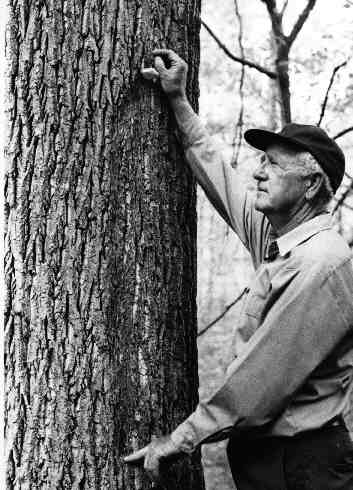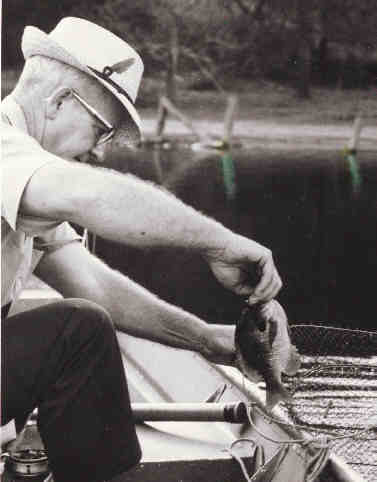| 06-03-02
Much could be said and written about the late Woodrow W. Fleming, a
high school biology teacher for 26 years, and the first (probably the only)
non-political director of our Division of Fish and Wildlife.
Woody, as friends and the scientific community knew him, died at 89
last week and was buried Saturday at Columbus' Garland Brook Cemetery.
One could write about Woody's accomplishments in wildlife conservation--there
were many. But the Woody Fleming story I choose to tell today has been
heard by few and I was privileged to hear it from the horse's mouth.
When the late Matthew Welsh became governor of Indiana in 1961, he named
Don Foltz, a western Indiana hog farmer, director of the Department of
Conservation (now the Department of Natural Resources). Woody, by chance,
was one of the candidates Foltz could choose from in naming a director
of the Division of Fish and Game (now the Division of Fish and Wildlife).
It was late on a winter afternoon when Foltz interviewed Woody--so late,
indeed, that Foltz suggested that they continue their talks over dinner
at a nearby restaurant. Indiana's political spoils system was rampant in
those day (it is alive and well today), and Foltz (presumably to test him)
asked Woody what he would do if he had to name a superintendent for the
Muscatatuck Game Farm, which was an important cog in Indiana's vaunted
artificial stocking program.
Foltz explained that there were two strong Democratic candidates for
the job of superintendent of the game farm. Their party credentials were
much the same, he explained, adding that regardless of whom he named, party
harmony would be at stake in Jennings County.
"Who would you give the job to?" Foltz asked. "I wouldn't give the job
to either of them," Woody later quoted himself, when he told me the story.
"I would close the game farm . . . and all the other game farms . . . if
you won't let me do that I don't want the job."
"He (Foltz) almost fell out of his chair." Woody told me.
The rest is history. Foltz gave Woody the job and a few months later
Indiana's massive game farm operation, which was pouring countless thousands
of dollars down rat holes, was closed amid a storm of protests from armchair
conservationists everywhere. The era of wild game stocking, per se, had
bit the dust . . . justifiably.
There are, of course, dozens of other stories I could tell about Woody
Fleming . . . like the time I flushed his first Indiana grouse on a Brown
County hillside and yelled: "Here he comes, Woody," to hear a single shotgun
blast a few seconds later and a startled Woody say: "I think I got him."
We looked everywhere for the bird without success. I finally found it
in a small lake, and if memory serves me correctly, I did some minor "skinny
dipping" to get Woody's bird--for which he dubbed me the finest retriever
he had ever hunted with.
At noon that day Woody built a nice wood fire in the fireplace of a
little cabin (on the property he owned) and (without a skillet) served
up one of the best pork chop dinners I have ever had . . . anywhere.
Another time, when Woody was introducing me to the fine fishing on the
Ohio River embayments above Markland Dam (upstream from Madison), we spent
an afternoon taking state-record spotted (Kentucky) bass, but never sought
the recognition that came with them.
When darkness came that afternoon, we turned into a little restaurant
nearby for din-din, then went back to the boat for frog hunting.Woody was
much impressed by the fact that I made 25 "grabs" that night and caught
24 bullfrogs.
"Shucks," I said modestly. "It was nothing."
I spent most of the night on my haunches in the bow of Woody's Jon-type
boat so I could catch the frogs that woody spotted with a strong light
from the rear seat while he guided the boat.
On one occasion, he spotted a big frog at water's edge, six feet or
so back under an outcropping of stone that was almost like slate. I had
to duck to get in under rocks, but I caught the frog. As woody backed the
boat out from under the stone, he stopped the boat just as my head
was a foot or so below the rocks.
I waited patiently, but the boat didn't move. Woody finally broke the
silence.
Look just above your head," Woody said, playing his strong light on
. . . a huge water snake coiled a foot above my head.
"OK," I said after a few seconds in which neither the snake nor
I had blinked, "you've had your fun . . . now get me out of here."
| Woody Fleming shows me
a four-foot scratch mark on a large tree (ash, I think, or yellow poplar).
Woody firmly believed the scratch mark was made by a big cat, probably
a cougar. The scrach mark started about 7 feet high on the tree and extended
downward to a point slightly below his waist. The scratch mark was roughly
two inches wide and went through roughly 1 1/2 (one and a half) inches
of bark to the wood of the tree. Woody discovered the evidence of big cats
being in Indiana as a timber manager after his years as director of the
Division of Fish an Game, in the late 1960s or early '70s. |
 |
 |
The late Woody Fleming
puts a husky bluegill in the live bag after taking it with a fly rod in
the 1970s. The fly rod was his favorite method of fishing and the bluegill
was one of his favorite fish. |
|

